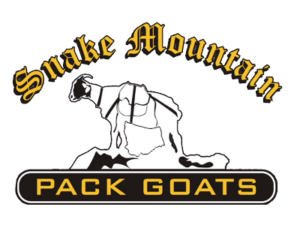4H Packgoat Project
Youth involved in the 4H Packgoat Project are committing to a long-term project that will involve several years of working with a packgoat. Research, record keeping, setting and achieving goals, and teamwork are skills youth will use throughout their lives.
The Packgoat Guidebook can be used in conjunction with youth organizations that offer a packgoat project. It contains special sections for youth enrolled in the Packgoat Project, Packgoat Project Leaders and Packgoat Project Judges.
Contact your local 4H office for further information!
NAPgA's Rendezvous & Academic Awards
The North American Packgoat Association (NAPgA) offers two monetary awards especially for youth! A $150 Annual Rendezvous attendance stipend and a $500 Academic Scholarship! Please feel free to share this information with any individuals or organizations that might be interested in these opportunities. If you have any questions please email us youth@napga.org. The deadline for the submission is June 1st of each year.
Packgoat Guidebook
NAPgA created the Packgoat Guidebook to help individuals learn about goatpacking and the practical skills associated with goatpacking responsibly.
It also contains special sections for youth enrolled in the 4H Packgoat Project, 4H Packgoat Project Leaders and 4H Packgoat Project Judges.
Designing a Packgoat Obstacle Course
Packgoat obstacle courses are a lot of fun and are a great learning experience for goats and handlers of all ages. They offer a test of your goat’s courage, obedience, athleticism, and intelligence. They also show off real world skills your goat has already learned at home and on the trail. Obstacle courses should offer a variety of challenges from easy to difficult, depending on the goats’ and handlers’ ages and abilities. While it might seem fun to create very challenging obstacles, keep in mind that the average packgoat is not a circus performer. Obstacles should generally relate to skills required in real life.
The obstacles shown here are mostly man-made, but it can be a lot of fun to use features found in a natural setting. Be creative but always keep safety in mind. Obstacles should be big and sturdy enough for the largest packgoats and handlers but sized so that smaller goats can also compete fairly. Making obstacles adjustable to the various sizes and skills of the goats is recommended when possible.
Easy Obstacles
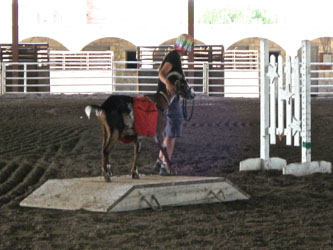
Bridge (easy):
Bridges are very easy for most goats, but points are deducted for balking, stepping off the side of the bridge, jumping over the bridge, not touching all four feet to it, or scooting over in a hurry.
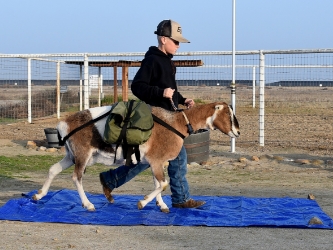
Tarp (easy):
Similar to the bridge, walking across a tarp is easy for most goats, but some may be put off by the unfamiliar crinkling sound.
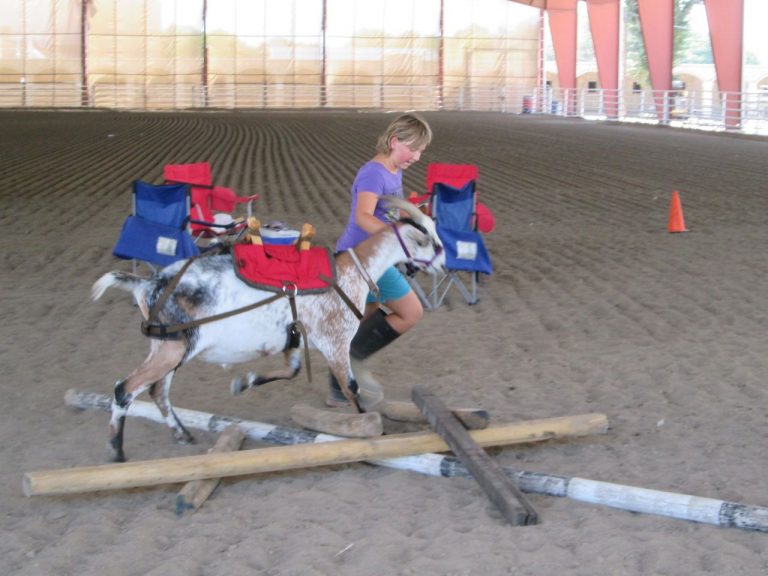
Jumble Poles (easy):
Make a pile of poles on the ground that the goat must walk through. High score for walking smoothly across the middle and not hitting the poles. Deduct points for balking, skirting near the edge, hitting poles, stumbling, rushing.
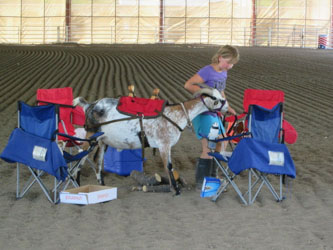
Campsite Etiquette (easy to moderate):
Set chairs around a campfire ring and put tasty food items on the chairs. Set pokers with marshmallows on the chairs and stick them toward the center to make this obstacle more challenging. You can get creative with a tent and tent stakes, a table full of food, etc. The handler and goat must successfully navigate a path through the campsite. Goats should not raid food, knock into chairs, pokers, or other obstacles, or trip on tent pegs. The goat should demonstrate attentiveness to his handler rather than food distractions. The goat should also show carefulness, and ability to negotiate tight turns.
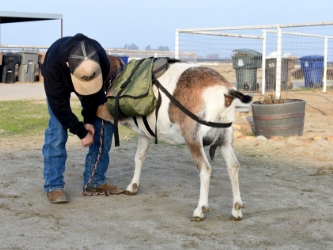
Hoof Care (easy to moderate):
Place a marker on the ground with a hoof brush on it. The goat should stop next to the marker while the handler picks up the hoof brush and drops the goat’s leash on the ground. The handler then picks up the goat’s left front foot and brushes it clean. To make this obstacle easier, have the handler hold the leash over one arm or grip it between their knees. To make it harder, have the handler clean all four hooves. The goat should stand still and lift his feet obediently.
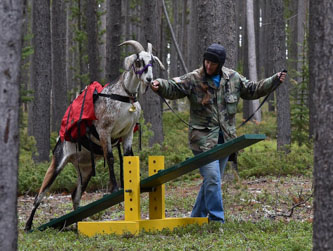
Teeter-Totter (easy to moderate):
A teeter-totter is a fun obstacle and usually easy for the goats depending on how it is constructed. An easy, low teeter-totter can be set up using a piece of plywood nailed to a round log. Make sure the teeter-totter goes smoothly back and forth. To increase the challenge, use a narrower board and raise the height of the fulcrum. Make sure that any teeter-totter you build is sturdy and can’t fall over or collapse under the weight of a full-sized packgoat. Also make sure it is not slippery. The steeper the teeter-totter, the more important this is. You can add wooden traction strips to the board and use traction paint.
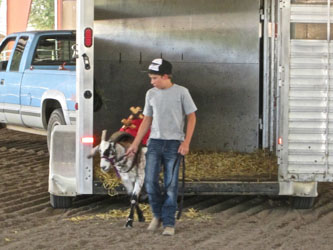
Truck/Trailer Loading (easy to difficult):
This is a very practical obstacle and it can be one of the easiest or hardest depending on how it is set up. A trailer is easy for most goats, but loading in a truck bed can be very difficult depending on how high the tailgate is and whether a step or ramp is provided. If a truck with no step is used then this obstacle demonstrates more than any other whether the goat has previously been taught to load at home. For novice classes, always use a trailer or a low vehicle. If using a full-sized truck for a novice class, make sure to provide a secure step that is tall enough and wide enough to make the jump inviting for young handlers and inexperienced goats.
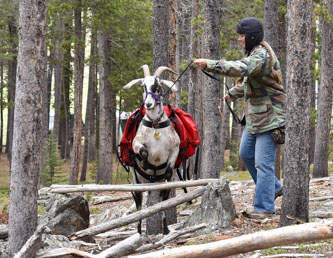
Jump (easy to difficult):
Jumps can be set low or high depending on the size and age of the goat, or they can be set both low AND high to allow the handler to choose the difficulty. For a “choose-your-own-difficulty” jump, set one end of the jump low at 6″ and the other end high at 2′ 9″. The handler chooses which part of the jump to cross. More points are awarded depending on how high the goat jumps. Points are deducted for balking or hitting the jump. No points are awarded if the goat knocks the jump down. Offering a choice makes young handlers consider their goat’s ability and training.
Ducking Under (easy):
Set a pole about 4 feet above the ground and hang “foliage” from it. The foliage can be as fancy as real tree branches, as “spooky” as foil streamers, or as basic as strings of baling twine. The pole should be high enough above the ground to accommodate goats wearing crossbuck saddles. Make sure the pole is secure so it can’t fall on goats or handlers! Points deducted for balking, bumping the pole with head or horns, or chewing the streamers.
Moderate Obstacles
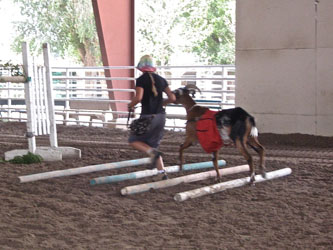
Trot Obstacle (moderate):
This practical demonstration obstacle can be set up any number of ways. It may have trot-over poles evenly spaced apart, weave poles/cones, or just a straight distance from one cone to another. If you are setting up this obstacle, make sure to leave plenty of distance to demonstrate a nice trot. This obstacle is often not given enough space. If using weave poles/cones, make sure they are set far enough apart that a big goat can successfully negotiate them at a trot. High score goes to goats who trot willingly on command without being dragged or struck from behind with the leash.
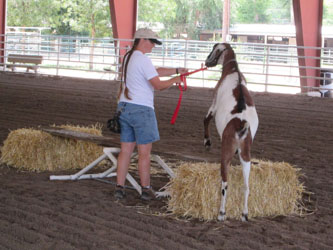
Narrow Bridge (moderate):
A narrow bridge can be set directly on the ground or elevated above it using a 2″ x 12″ board about 12 feet long. Above-ground bridges are psychologically easier for the goat but must be safely constructed and not too high (I heard about one that was 5′ off the ground and a goat fell off it!). Straw bales, cinder blocks, and log rounds all make good end supports. The board should be supported in the middle so a heavy goat can’t crack it. If a suitable board isn’t available, this obstacle can be set up using two 12′-long poles set about 12″ apart. The goat must walk between the poles without stepping on them or outside them. Some goats will demonstrate a natural ability to walk on top of one pole for the entire length. While certainly amusing, this is not worth extra points.
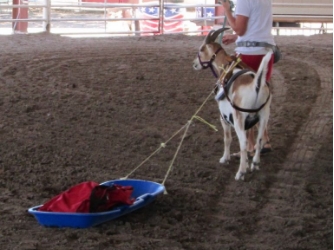
Sled Drag (moderate):
Have the goat drag a sled weighed down with about 15 lbs. so it doesn’t slither and bounce. Putting firewood or camping gear in the sled makes this obstacle feel practical. Make sure the drag rope has a handle loop and is long enough that the sled can’t hit the goat’s back legs. Goats with packsaddles should have the rope looped around the front crossbuck. If the goat does not have a saddle, the handler should lead the goat with one hand and drag the sled with the other. Have them pull the sled around a marker and back. You can vary this obstacle by having the goat drag a tree branch or other item. Just make sure it’s something a child can easily pull. You can also make the obstacle more difficult by having the goat drag a “spookum” such as a bunch of empty milk jugs tied together, or a bag full of rattling aluminum cans.
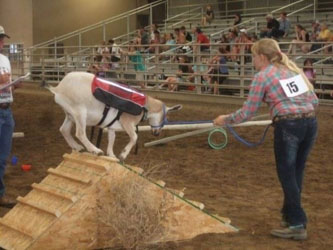
Pyramid (moderate):
A variation of the bridge, this obstacle is a lot of fun for most goats but can be a real poser to others. It should be steep enough to create a challenge but not so steep as to be dangerous. Make sure this obstacle has good traction strips.
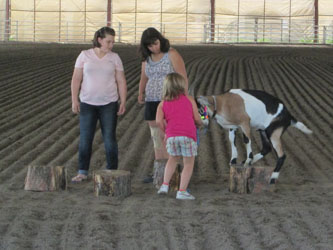
Stepping Stumps (moderate):
Set up a series of 3-5 stumps and have the goat step from one to the other without touching the ground. This obstacle seems easy, but most goats have a tendency to step down between or abandon the stumps entirely in favor of walking on the ground. Make sure the stumps are large enough to accommodate a full grown goat and that they are short and wide enough to prevent wobbling or tipping. Space them at such a distance that the average goat can step from one to the other without jumping.
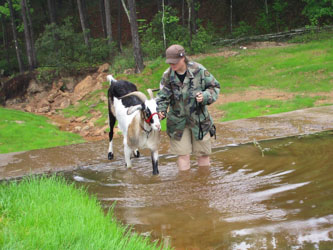
Water Crossing (moderate to difficult):
Depending on how you set it up, this can be one of the most challenging obstacles on any course. Fill a plastic pool with water. Add dirt to the bottom for traction. This obstacle is often presented in amateur classes as an amusement for the audience since most goats absolutely will NOT step into the pool and both goat and handler end up wet. This isn’t very fair since smaller goats can be dragged in and complete the obstacle without training because they haven’t got the physical strength to avoid it. To make this obstacle easier, put a stump in the center so the goat can hop over the water without getting his feet wet. Adding a stepping stump reduces the spectacle, but it shows which goats lead willingly over water and which don’t. For an advanced class, goats should be required to walk through the pool, stepping all four feet in the water.
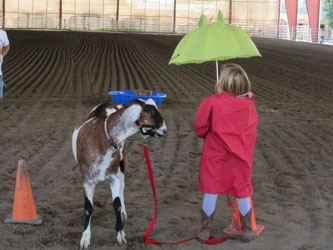
Standing Still for Spooks (moderate to difficult):
This obstacle can be presented many different ways. The photo here is of a girl who has put on a raincoat and opened an umbrella while her goat ground ties next to her. The handler had to walk around the goat with the umbrella open. Another way to do this would be to have a raincoat or tarp placed in the packsaddle before the start of the course. At some point the handler would have to stop the goat, remove the “scary” item and shake it out/put it on while the goat stands. You can also have a handler remove and replace a packsaddle, throw a tarp or blanket over a goat, etc. To make this obstacle easier, amateur competitors may hold the lead rope. The main objective is to demonstrate that the goat will stand still and not spook at the item that is being presented.
Difficult
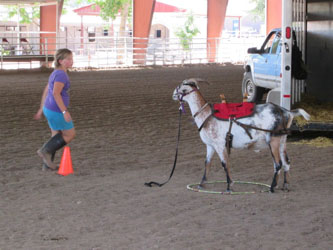
Ground Tie (difficult):
This is one of the more practical demonstrations on an obstacle course. It shows that the goat has been worked extensively at home and is obedient to the “whoa” command when not restrained. Place a hula hoop on the ground and have handlers park their goat’s front feet inside the hoop. They should then drop the rope and walk around a cone placed 8-10 feet away. The goat’s front feet must remain inside the hoop to get points. Points are deducted if the goat moves or if the handler rushes. Adjust the difficulty by moving the cone closer or further from the hoop.

Unfamiliar Dog (difficult):
Use a calm, gentle dog that is not familiar to any of the goats and place it in a wire pen . Have the goats walk by within a certain distance or stand near a marker, but never make them approach closer than 4 feet. The goat should approach and pass the dog willingly with eyes and ears on alert but without rushing or spooking. Difficulty can be adjusted by determining how close the goat must approach and whether he must also stand for a time. Bonus points can be awarded to goats that behave well when the dog is excited. Under no circumstance should the goat and dog be close enough to make contact! To avoid traumatic experiences, this obstacle is recommended for goats at least 2 years old with accomplished handlers.
All Natural Obstacle Course
With the exception of the teeter-totter and the umbrella/tarp at the end, these obstacles were created using only the natural features available near our campsite. This course was set up at Rendy 2019 near Buffalo, WY.







